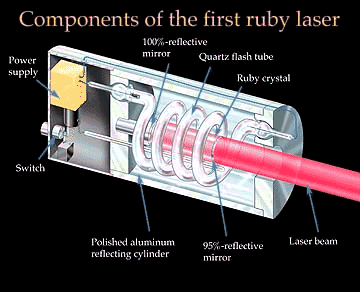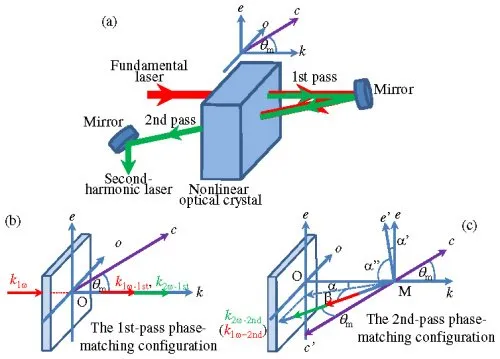In the last post we concluded our discussion on classical electromagnetism. Non-linear optics comes about when the amplitude of electric field perturbation is no longer small.

Lasers
Laser Light vs. Black Body Light
In black body light, there are a spread of wavelengths and photons are emitted in all directions. Laser light, however, is of single wavelength, and highly directional. The polarisation of black body light is random, but individual photons in laser light are of identical polarisation. Laser light is coherent.
Necessary Criteria for Lasing
- The laser medium must provide gain. In order to achieve this, energy must be provided to the system tso that a population inversion between the upper and lower lasing levels can be established.
- There must be feedback to establish stimulated emission. This is achieved by placing the laser medium between two mirrors in order to regenerate the stimulating photon.
Optical Pumping
The first laser was produced by Theodore Maiman in 1960, which was made from a simple photographic coiled flashlamp and a ruby crystalline rod, which operated in the visible region of the spectrum. It used light to produce light. This is known as optical pumping.

Another possibility that exists is the generation of laser light via electricity. This was realised via the semiconductor laser in 1962.
Non-Linear Optics
- In order to observe non-linear optical effects in optical materials, it is necessary to drive the oscillator hard - i.e. a laser is required.
- We are no longer able to utilise the approximation of simple harmonic motion, where the amplitude of the dipole oscillation is proportional to the strength of the perturbing electric field, since this field is no longer small. We have anharmonic motion.
- An imperfect sinusoid has new frequencies since its description requires extra fourier components.
Lets consider, for a moment, an ideally linear optical material. Ignoring the frequency dependence of the polarisation, we may write

where chi is a dimensionless constant known as the electric susceptibility. It is the case that at high fields, the polarisation must eventually saturate since it cannot increase without bound. We therefore represent the polarisation in a more useful way, as a series expansion in the electric field

Now, the general plane-wave solution of Maxwell's equations is

which we will simplify by considering only the time varying component. Therefore, the polarisation becomes

This can be rearranged into a more useful form via trigonometric identities to yield

2nd Harmonic Generation
So what does the above analysis imply about practical application? We can generate light of different colours using a non-linear crystal.
